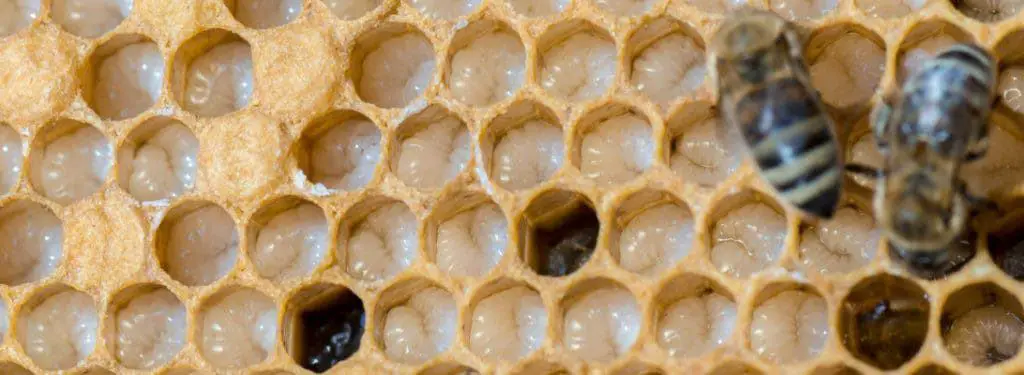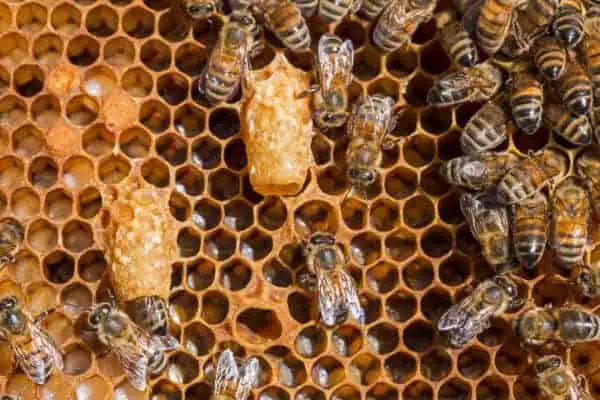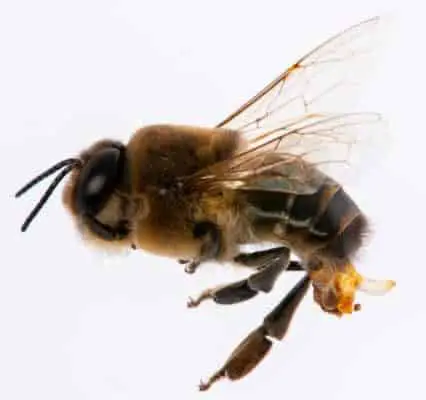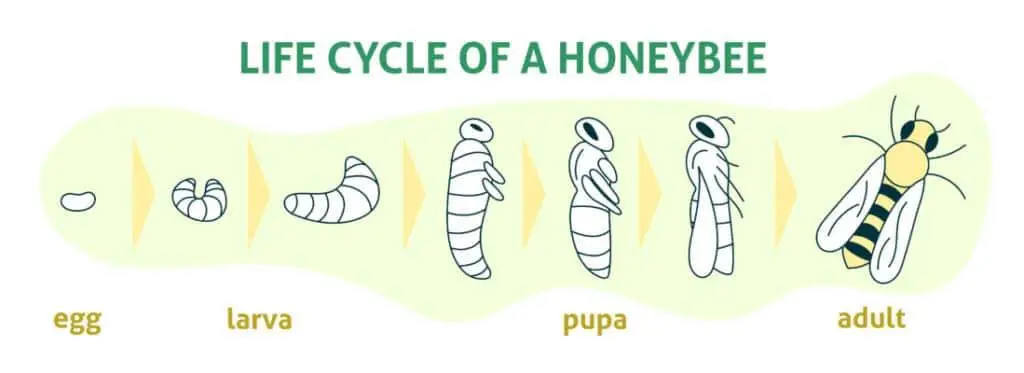
A healthy hive of bees will vary in population from 10,000 to 100,000+ bees. This will differ depending on the age of the hive, what season it is, and the number of food resources available within the range of flight for foraging. Regardless of numbers, there is only ever one queen bee and she is responsible for giving life to all the bees in the hive.
This poses the question, how do bees reproduce?
A virgin queen makes her mating flight. Male bees, “drones”, mate with her mid-flight. The fertile queen returns to the hive and lays eggs in wax cells. Hatched larvae are fed by worker bees until the cell is capped for pupation. Pupa now transforms into an adult bee before emerging from the cell.
Who decides who the queen is going to be?
The future queen bee is carefully selected as an egg by the worker bees. From the time she hatches she is given the royal treatment. As a larva in the cell, she is fed royal jelly or bees milk which is a protein and carbohydrate-rich mix secreted from the hypopharynx glands within the head of the nurse bees.
The royal jelly is fed to the future queen throughout her life, not only during the larvae phase. In the image below you can see a worker bee inside a queen cell feeding the queen larva.

It is the worker bees responsibility to decide when her reign as queen will come to an end. As the queen ages and becomes less fertile the worker bees will supercede her creating a new queen in her place. The workers will often kill the older queen once the new queen has established reign.
How old is a queen when she does her mating flight?
Once the queen has emerged from the queen cell she is fed and cared for by worker bees. On day 5 she will reach her sexual maturation. In the days following, the queen will make some orientation flights circling the hive in an increasing range from the hive. A queen bee will typically only embark on two or three orientation flights in total. These flights are appropriated in the warmest part of the day and only last around one to two minutes. These important flights are actioned over the course of 1 to 3 days depending on weather conditions.
With orientation flights complete the virgin queen will embark on her mating flights between day 6 and day 10 of life. The queen will wait on favourable weather conditions before flight. Elements of rain and wind add risk of death to the all important queen.
If the queen is to die on her mating flight it can prove catastrophic for her hive and has the potential to kill the hive. If the preceding queen is dead and has not laid any fertilized eggs in the last seven days it will be too late for the hive to make another queen.
What is drone bees role in the hive and how do they mate with the queen?
Drones are the male bees in the hive. Their primary role in life is to mate with a queen bee. Their only other contribution to the hive is during seasonal temperature fluctuations. These bees are very discerning when it comes to hive temperature and have the ability to use their body to regulate the temperature.
Drones, like worker bees, contribute to temperature regulation in the Summer by fanning their wings when the hive is too hot and in the Winter by rapidly vibrating their abdomens to create heat when the hive is cold.
Having said this, in regions with cold winters drones will often be kicked out of the hive in the where they will die of starvation, exposure to the elements or become a meal for an opportunistic predator. The reason for this is drones provide little to the survival of the hive in through the WInter when food resources are scarce. Eliminating the drones means less mouths to feed.
Drones will commonly fly in the afternoons weather permitting to “drone congregation areas” (DCA). These flights will last 30 minutes on average but can be as long as 60 minutes before the drone needs to return to the hive to be fed. This food stop is necessary to replenish and restore his energy ready for another flight.
DCA’s are most often 1km to 2 km ( 0.6 to 1.2 miles) away from the hive. The area is a meeting place for drones from an array of hives within the local area. This is how genetic diversity is achieved with estimates of up to 25,000 drones congregating at any one time from up to 200 different hives.
When a virgin queen enters the DCA she is set upon by the drones in the immediate area. Only the strongest drones will reach her. She will mate with between 5 and 20 drones in total during her mating flights. The majority of queens will only do one mating flight however two or three mating flights are not uncommon.
Unfortunately for the drones, there is only a 1 in 1000 chance that he will successfully catch and mate with a queen. The mating act takes about 5 seconds and is performed in flight with the drone mounting the queen from behind in a vertical position. The drone inserts his endophallus into the queen’s open sting chamber. Once inserted the drone is paralyzed and rolls off the queen as he is able to fertilize the queen.
This consummation is likened to a small explosion loud enough to be heard by the human ear. The sheer force of the drone’s successful mating blasts his seed past the queen’s sting chamber and into the oviduct fertilizing the queen.
Sadly for the drone this process ruptures the endophallus separating him from the queen and dramatically ending his life. In doing this he is one of only a few who will courageously fulfill his life’s purpose.

Prior to mating with a number of drones, a fertilized queen will carry up to 100 million sperm in her oviduct immediately ready to fertilize eggs. She will store a further 5 to 7 million sperm in her spermatheca which can keep them fresh for up to 4 years.
The sperm she has captured needs to last her for her lifetime as she will not leave the hive again to mate.
How many eggs can a queen lay?
About 2 to 3 days after the young queen’s successful mating flight the she will begin to lay eggs in the cells of the combs. The combs with eggs in them are known as brood combs.
A young queen at her peak can lay more than her body weight in eggs, up to 2000 eggs per day each measuring around half the size of a grain of rice. To achieve this she is repeatedly fed royal jelly by worker bees. The royal jelly is very high in energy and protein.
Does the queen decide if the eggs will make male or female bees?
Before each egg is laid the queen determines the sex of the bee that will form inside the cell. As the egg passes through the oviduct the queen can decide if the egg is to be fertilized or not. One of the factors in this decision is the type of cell she is laying in. Drone cells are larger in size to the more common brood cells for worker bees. Drones come from an unfertilized egg and worker bees and queens originate from fertilized eggs.
The queens can lay for up to 4 years however in reality she will begin to lay more unfertilized eggs as she ages. The worker bees keep a close eye on the queens performance. The role and performance of the queen is paramount to the survival of the hive.
As a part of the hives lifecycle, if the queen’s ability to lay fertilized eggs drops off, the worker bees will create new queen cells and kill the existing queen by balling up around her and smothering her.
This is a risky time for the hive because if a new queen is not successfully fertilized and/or does not return to the hive safely it will mean the death of the hive unless a new queen can be introduced by a beekeeper.
How long does it take from the egg to the adult bee?
Before a queen bee lays an egg in a cell she inspects it for cleanliness and condition. She will not lay in damaged cells. When the queen lays the egg it has a strand of mucus that attaches it to the bottom of the cell, holding it in place.
There are three phases to reproduction of honey bees:
- Egg Phase
- Larva Phase
- Pupa Phase

1. Egg Phase
The egg will incubate in the cell for 3 days. During this time the nervous and digestive systems are developing. After 3 days the larvae will emerge from the egg. This phase of development is the same for queen bees, worker bees, and drones.
2. Larva Phase
From day 3 to day 9 the worker bee will be in the larvae state. Queens are about half a day less at 8.5 days and drones are a little longer at 9.5 days. On their respective days the cells are capped by the worker bees.
In the first three days after hatching, all larvae, queens, workers and drones are fed royal jelly by worker bees. The queen will continue to be fed royal jelly for not only the remainder of the larval stage but for the rest of her life after emergence.
Worker bees and drones will be fed bee bread after day 3 and for the remainder of the larval stage. Bee bread is a blend of honey and pollen. Honey for energy and pollen for protein.
3. Pupa Phase
Queens will stay in the capped cell as a pupa for 8 days before emergence from the cell. The development time for the queen is a total of 16 days. Her adult length is 18mm to 22mm with an average weight of 200mg.
Worker bees will stay in the capped cell as a pupa for 11 days before emergence from the cell. The development time for the worker bee is a total of 21 days. Her length is 12mm to 15mm with an average weight of 100mg.
Drones will stay in the capped cell as a pupa for 14 days before emergence from the cell. The development time for the drone is a total of 24 days. His length is 15mm to 17mm with an average weight of 200mg.
| Worker Bee | Drone Bee | Queen Bee | |
| Egg Phase | Day 0 to Day 3 | Day 0 to Day 3 | Day 0 to Day 3 |
| Larval Phase | Day 4 to Day 9 | Day 4 to Day 9.5 | Day 4 to Day 8.5 |
| Pupa Phase | Day 10 to Day 21 | Day 10 to Day 24 | Day 9 to Day 16 |
| Egg to Emergence | 21 Days | 24 Days | 16 days |
The Wrap Up.
The way bees reproduce is not only fascinating from a biological perspective but also from a hive management perspective. This superorganism can within 3 weeks scale up and down their brood production as required during a season or relative to the food resources available to them.
